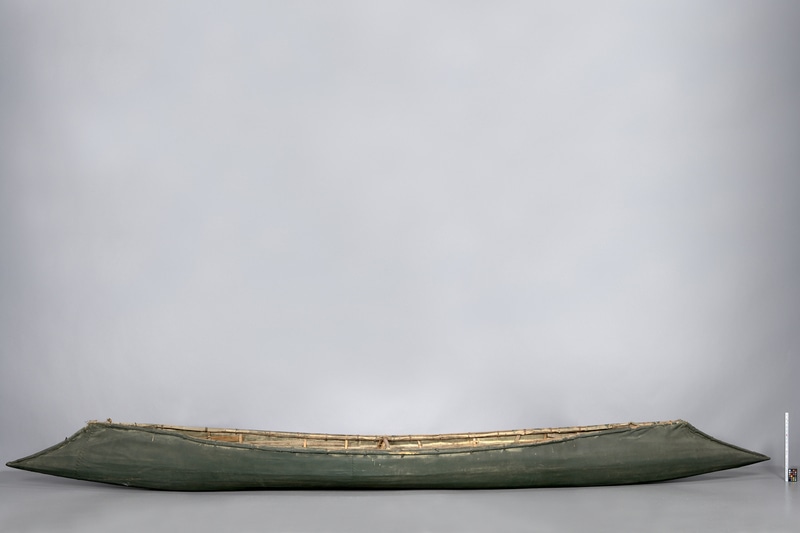Sturgeon Nosed Canoe Item Number: Nd714 from the MOA: University of British Columbia


Description
Canoe hull has long, pointed bow and stern, creating sharp angle back up to top rim (gunwale). Black painted canvas over rib and slat wood frame. Nails along inner top gunwale, metal wire at each end. Bark and cloth lashings used on frame. Middle stabilizing bar (thwart), no seats.
History Of Use
Ktunaxa (pronounced ‘k-too-nah-ha’) people traditionally occupied the lands adjacent to the Kootenay and Columbia Rivers and the Arrow Lakes of British Columbia, and are renowned for their distinctive yaksumit, or “Sturgeon-nosed" canoe. The unique flat bottom design tapers on both ends resulting in a streamline shape that cuts easily through the water. Sturgeon-nosed canoes were traditionally made from birch bark, western white pine bark, cedar wood and roots, maple sap and pitch. The light construction made for easy transport on lakes and marshy wetlands. Cedar strips sewn together with sinew or hide strips would be placed on the bottom of the canoe for the area where the paddler sits; the canoes were not normally constructed with seats as the paddler knelt directly on a cedar mat at the bottom of the boat, his feet under him and his knees spread hard against the sides. Normally the thwart would have an O ring to hold the paddle when not in use. Today, sturgeon-nosed canoes are made primarily by the Yaqan Nukiy people (also known as the Lower Kootenay Indian Band).
Cultural Context
transportation; fishing
Narrative
Information on file, which apparently came from the donor, says the canoe was collected from an elderly First Nations woman who said it was made 100 years earlier in the traditional style. The original covering of the canoe was said to have been bark from the wild cherry tree (prunus emarginata), sewn together. The bark was replaced with canvas at some point; the frame work is original. The donor's son said the canoe was collected from the Creston Reserve.
Item History
- Made in British Columbia, Canada during 1880
- Collected in Creston, British Columbia, Canada during 1950
- Owned by James Dunn before August 9, 1972
- Received from James Dunn (Donor) on August 9, 1972
What
- Name
- Sturgeon Nosed Canoe
- Identification Number
- Nd714
- Type of Item
- canoe
- Material
- bark, cotton fibre, paint, metal and white pine wood
- Overall
- height 0.4 m, width 0.7 m, depth 4.9 m
Who
- Culture
- Ktunaxa
- Previous Owner
- James Dunn
- Received from
- James Dunn (Donor)
Where
- Holding Institution
- MOA: University of British Columbia
- Made in
- British Columbia, Canada
- Collected in
- Creston, British Columbia, Canada
When
- Creation Date
- during 1880
- Collection Date
- during 1950
- Ownership Date
- before August 9, 1972
- Acquisition Date
- on August 9, 1972
Other
- Condition
- fair
- Current Location
- Case 31
- Accession Number
- 0207/0001